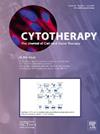嵌合抗原受体T细胞免疫治疗癌症的下一个创新。
IF 3.2
3区 医学
Q2 BIOTECHNOLOGY & APPLIED MICROBIOLOGY
引用次数: 0
摘要
嵌合抗原受体(CAR) T细胞疗法已经改变了癌症治疗和免疫治疗领域。尽管CAR - T细胞疗法在治疗B细胞恶性肿瘤方面取得了相当大的临床成功,但扩大其治疗其他血液系统恶性肿瘤和实体肿瘤的疗效和可及性仍然是一个挑战。关键的限制包括制造限制和治疗障碍,如CAR - T细胞的持久性、增殖、肿瘤运输和治疗相关的毒性。为了克服与CAR - T细胞治疗相关的独特挑战,可以利用CAR - T设计、递送和T细胞功能方面的新技术进步。本文将探讨三种创新方法:基因编辑和沉默、装甲策略和体内CAR基因递送。这些方法都旨在提高CAR - T细胞治疗血液系统恶性肿瘤的可及性和治疗效果。本文章由计算机程序翻译,如有差异,请以英文原文为准。
The next innovations in chimeric antigen receptor T cell immunotherapies for cancer
Chimeric antigen receptor (CAR) T cell therapy has transformed cancer treatment and the field of immunotherapy. Although CAR T cell therapy has demonstrated considerable clinical success for the treatment of B cell malignancies, expanding its therapeutic efficacy and accessibility for other hematological malignancies and solid tumors remains a challenge. Key limitations include manufacturing constraints and therapeutic hurdles, such as CAR T cell persistence, proliferation, tumor trafficking and treatment-related toxicities. To overcome the unique challenges associated with CAR T cell therapy, novel technological advancements in CAR design, delivery, and T cell functionality can be leveraged. This review will explore three innovative approaches: gene editing and silencing, armoring strategies and in vivo CAR gene delivery. These approaches are all aimed at enhancing the accessibility and therapeutic efficacy of CAR T cell therapy in hematological malignancies.
求助全文
通过发布文献求助,成功后即可免费获取论文全文。
去求助
来源期刊

Cytotherapy
医学-生物工程与应用微生物
CiteScore
6.30
自引率
4.40%
发文量
683
审稿时长
49 days
期刊介绍:
The journal brings readers the latest developments in the fast moving field of cellular therapy in man. This includes cell therapy for cancer, immune disorders, inherited diseases, tissue repair and regenerative medicine. The journal covers the science, translational development and treatment with variety of cell types including hematopoietic stem cells, immune cells (dendritic cells, NK, cells, T cells, antigen presenting cells) mesenchymal stromal cells, adipose cells, nerve, muscle, vascular and endothelial cells, and induced pluripotential stem cells. We also welcome manuscripts on subcellular derivatives such as exosomes. A specific focus is on translational research that brings cell therapy to the clinic. Cytotherapy publishes original papers, reviews, position papers editorials, commentaries and letters to the editor. We welcome "Protocols in Cytotherapy" bringing standard operating procedure for production specific cell types for clinical use within the reach of the readership.
 求助内容:
求助内容: 应助结果提醒方式:
应助结果提醒方式:


